 Gilman Studio On-Line Lessons
Gilman Studio On-Line Lessons
Tai Chi Partner Cane Form
This Lesson Contains:
Movement # 4 – The Dragon Attacks
This is a fun movement. Here the opponent strikes towards my head. I duck, guarding my head with my cane, and attack his knee. He falls back and I follow by stepping in and attacking his head. If you lack the flexibility to duck all the way down so the right knee touches the ground, you can squat as low as you feel comfortable. If you have done Swimming Dragon Chi Gong you’ll know this movement.
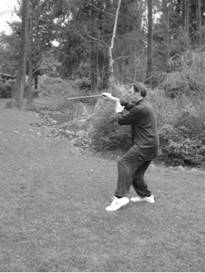
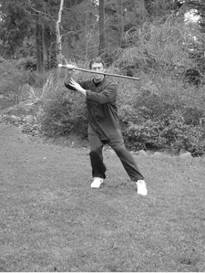 As the opponent swings his cane towards my head, I start to duck as I bring up the cane to guard.
As the opponent swings his cane towards my head, I start to duck as I bring up the cane to guard.
Shift the weight back onto the right foot and empty the front foot by touching down the toe. One can also jump back a bit here onto the right foot.
The cane moves into a parallel to the ground position as it moves up to cover the head. This is done by bringing the right arm slightly back towards the right side of the head. The left hand touches the right forearm for support.
Focus on the energy dropping down.

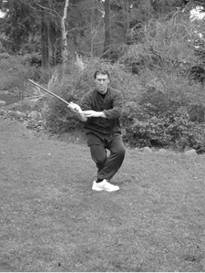 The cane makes a nice big circle on top of the head and starts its attack to the knee.
The cane makes a nice big circle on top of the head and starts its attack to the knee.
Replace the left foot in front of the body at about a right angle to the forward direction (west). At this point the left toe faces south. Sink the weight onto the leg and do try to keep the body upright. The right knee can go any distance down. It mostly depends upon how far in front you replace the left foot. The further away from the body, the lower the body can go.
The cane swings around in a clockwise direction (as you look up at it). This is a snapping kind of movement. Here, the cane is almost ready to finish the attack.
Focus on the target as the opponent’s cane has by now passed over head.
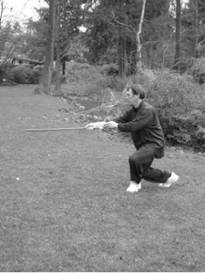
 The first attack to the knee is now complete.
The first attack to the knee is now complete.
The body is in the same position as before. The weight is mostly on the left leg. Again, be careful not to lean too far forward.
The cane is extended out at knee level in front of the body. Keep the shoulders and elbows relaxed.
Focus on the cane tip.
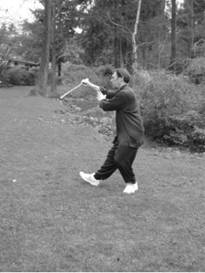
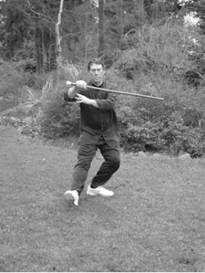 The opponent neutralizes my first attempt and he steps back. I follow and attack his temple.
The opponent neutralizes my first attempt and he steps back. I follow and attack his temple.
Step ahead with the right foot to face west. Keep the energy in the left Kua for later release.
The cane continues to make another circle in front of the body. This time it is spiraling up, whereas before it was spiraling down. It is continuing in the same direction. When done correctly, the spirals just continue as you duck, and step forward.
Focus on the target.
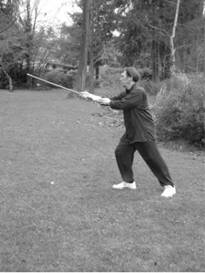
 The second attack, to the temple, is complete.
The second attack, to the temple, is complete.
Shift the weight onto the right foot. The toe and torso face west. The power for this strike to the temple comes from the legs, to the left Kua, to the waist and is snapped out into the arm. The left Kua is so important in this release.
The cane tip ends at temple level extended out at about a 45-degree angle. Keep the shoulders and elbows relaxed.
Focus on the cane tip.
